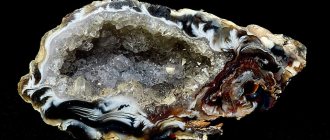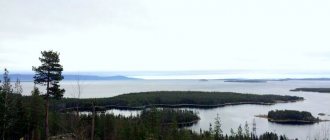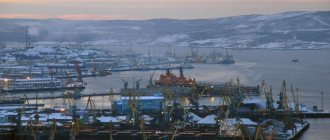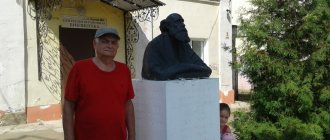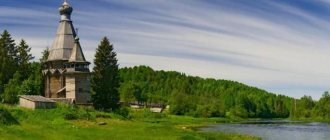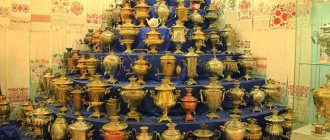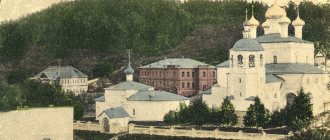Coat of arms
City coat of arms
Date of adoption: 10.1980
Description: The shape of the coat of arms is based on a French shield crossed by a gold belt with a jagged protrusion at the bottom. The belt represents a stylized image of an iron ore quarry with its sides depicted. On the tip of the black color is the gold symbol for the chemical symbol of iron, Fe. In the upper silver field there is a gold “compass rose” superimposed on a black ball. The diagonal elements of the “wind rose” symbolize magnetite crystals, which are shaped like octahedrons. The contrast of the silver and black colors of the coat of arms means: the decisive intervention of a person who wants to have black metal in the virgin snow-covered nature of the North.
The author of the coat of arms is the architect Mikhail Ivanovich Yakovlev.
Excerpt characterizing Kovdor
Having uttered these words, she approached the doctor. “Cher docteur,” she told him, “ce jeune homme est le fils du comte... yat il de l'espoir?” [this young man is the son of a count... Is there hope?] The doctor silently, with a quick movement, raised his eyes and shoulders upward. Anna Mikhailovna raised her shoulders and eyes with exactly the same movement, almost closing them, sighed and walked away from the doctor to Pierre. She turned especially respectfully and tenderly sadly to Pierre. “Ayez confiance en Sa misericorde, [Trust in His mercy,”] she told him, showing him a sofa to sit down to wait for her, she silently walked towards the door that everyone was looking at, and following the barely audible sound of this door, disappeared behind it. Pierre, having decided to obey his leader in everything, went to the sofa that she showed him. As soon as Anna Mikhailovna disappeared, he noticed that the glances of everyone in the room turned to him with more than curiosity and sympathy. He noticed that everyone was whispering, pointing at him with their eyes, as if with fear and even servility. He was shown respect that had never been shown before: a lady unknown to him, who was speaking with the clergy, stood up from her seat and invited him to sit down, the adjutant picked up the glove that Pierre had dropped and handed it to him; the doctors fell silent respectfully as he passed them, and stood aside to give him room. Pierre wanted to sit in another place first, so as not to embarrass the lady; he wanted to lift his glove himself and go around the doctors, who were not standing in the road at all; but he suddenly felt that this would be indecent, he felt that this night he was a person who was obliged to perform some terrible ritual expected by everyone, and that therefore he had to accept services from everyone. He silently accepted the glove from the adjutant, sat down in the lady’s place, placing his large hands on his symmetrically extended knees, in the naive pose of an Egyptian statue, and decided to himself that all this should be exactly like this and that he should do it this evening, so as not to to get lost and not do anything stupid, one should not act according to one’s own considerations, but one must submit oneself completely to the will of those who guided him. Less than two minutes had passed when Prince Vasily, in his caftan with three stars, majestically, holding his head high, entered the room. He seemed thinner since the morning; his eyes were larger than usual when he looked around the room and saw Pierre. He walked up to him, took his hand (which he had never done before) and pulled it down, as if he wanted to test whether it was holding tightly. - Courage, courage, mon ami. Il a demande a vous voir. C'est bien... [Don't lose heart, don't lose heart, my friend. He wanted to see you. This is good...] - and he wanted to go. But Pierre considered it necessary to ask: “How is your health?” He hesitated, not knowing whether it was proper to call a dying man a count; He was ashamed to call him father. – Il a eu encore un coup, il ya une demi heure. There was another blow. Courage, mon ami... [Half an hour ago he had another stroke. Don’t lose heart, my friend...] Pierre was in such a state of confusion of thought that when he heard the word “blow,” he imagined the blow of some body. He looked at Prince Vasily, perplexed, and only then realized that a blow was a disease. Prince Vasily said a few words to Lorren as he walked and walked through the door on tiptoe. He could not walk on tiptoes and awkwardly bounced his whole body. The eldest princess followed him, then the clergy and clerks passed, and people (servants) also walked through the door. Movement was heard behind this door, and finally, with the same pale face, but firm in the performance of duty, Anna Mikhailovna ran out and, touching Pierre’s hand, said: “La bonte divine est inepuisable.” C'est la ceremonie de l'extreme onction qui va commencer. Venez. [God's mercy is inexhaustible. The unction will begin now. Let's go.] Pierre walked through the door, stepping on the soft carpet, and noticed that the adjutant, and the unfamiliar lady, and some of the other servants all followed him, as if now there was no need to ask permission to enter this room. Pierre knew well this large room, divided by columns and an arch, all upholstered in Persian carpets. The part of the room behind the columns, where on one side stood a high mahogany bed under silk curtains, and on the other a huge icon case with images, was red and brightly lit, as churches are lit during evening services. Under the illuminated vestments of the icon case stood a long Voltairean armchair, and on the armchair, covered at the top with snow-white, apparently uncrumpled, pillows, covered to the waist with a bright green blanket, lay the majestic figure of his father, Count Bezukhy, familiar to Pierre, with the same a gray mane of hair, reminiscent of a lion, above a wide forehead and with the same characteristically noble large wrinkles on a beautiful red-yellow face. He lay directly under the images; both of his thick, large hands were pulled out from under the blanket and lay on him. In the right hand, which lay palm down, between the thumb and forefinger, a wax candle was inserted, which, bending over from behind the chair, was held in it by an old servant. Above the chair stood the clergy in their majestic shiny robes, with their long hair hanging out, with lighted candles in their hands, and slowly solemnly served. A little behind them stood two younger princesses, with a scarf in their hands and near their eyes, and in front of them was the eldest, Katish, with an angry and decisive look, never taking her eyes off the icons for a moment, as if she was telling everyone that she was not responsible for herself if looks back. Anna Mikhailovna, with meek sadness and forgiveness on her face, and the unknown lady stood at the door. Prince Vasily stood on the other side of the door, close to the chair, behind a carved velvet chair, which he turned back to himself, and, leaning his left hand with a candle on it, crossed himself with his right, each time raising his eyes upward when he put his fingers to his forehead. His face expressed calm piety and devotion to the will of God. “If you don’t understand these feelings, then so much the worse for you,” his face seemed to say.
General information
The city of Kovdor is located 373 km southwest of the regional center on the slopes of the Manselka hill. The population of the city is about 24 thousand people.
As a settlement, Kovdor was founded in 1953 in connection with the development of iron ore deposits. The construction of a mining and processing plant began, which became the city-forming enterprise.
City status since 1965. Now the mining and processing plant (production of iron and apatite concentrate) is one of the largest in Russia, distinguished by large production volumes and high quality of products.
The life of the city is completely connected with the work of the mining and processing plant: after all, the vast majority of the city’s population works at this enterprise.
Border is locked tight?
Today, in the Murmansk region there are two international automobile checkpoints on the border with Finland: Salla and Lotta (Raja-Joseppi). In addition, there is a checkpoint Borisoglebsk (Storskog) on the border with Norway. But this doesn’t make it any easier for Kovdor.
— A paradoxical situation arises: Finland is only 26 kilometers away, but to get there you need to make a detour of 320 kilometers. It is clear that neither we nor they will visit us again,” explains the head of the local travel agency that carries out cross-border cooperation with partners from Finland, Artur Belyanin.
Young people are slowly leaving the city, although the presence of a checkpoint and, as a consequence, the development of international tourism would help create new jobs, and therefore new prospects for Kovdor residents.
In addition, the opening of the road would increase the investment attractiveness of the area and contribute to the development of trade relations between local enterprises and Finnish partners.
And the Finns would not be averse to creating a common tourist route with Kovdor. They themselves promote “Gerda’s Path to the Snow Queen”; Rovaniemi, the residence of the Finnish Santa Claus, is located nearby. Finally, there are Sami communities on both sides of the border. Representatives of this small people would be able to communicate with their fellow tribesmen and develop cultural exchange if an international automobile checkpoint appeared.
The head of the Kovdor district imagines in detail a road that can lead the municipality out of a dead end:
— Today it is unpaved, 26 kilometers. You can leave it unpaved for the first period, but make the surface so that you can drive a car. Four kilometers will be built entirely from scratch - between Russia and Finland on neutral territory, and about 30 kilometers - on the Finnish side. Plus the checkpoint itself,” Sergei Somov enthusiastically explains.
The price of the issue is not yet known exactly: the municipality has not yet ordered an official road project. But, according to the director of the Institute of Transport Economics and Transport Policy at the Higher School of Economics, an expert in the field of transport and road infrastructure, Mikhail Blinkin, four kilometers of primer with decent coverage will cost 10 million rubles. A road category 1A (motorway) or 1B (expressway) will cost 10 times more. Completing the work, if desired, is a matter of one construction season.
Nature
The nature of the Kola Peninsula, on which the city of Kovdor is located, is rich in its forests, rivers, rivulets, and lakes. These are unique and beautiful places. Kovdor is located beyond the Arctic Circle, and therefore there are northern lights on a winter night, which lasts 7 months, and white summer nights, when it practically does not get dark. The entire Kola Peninsula consists of hills called Khibiny (low mountains), the maximum height of which does not exceed 1000 meters, which provides the Kola Peninsula with good ski resorts, for example, in Kovdor, as a local attraction, there is “Bald Hill”, this is a hill (small mountain) with prepared route, which is why when looking at the hill from a long distance it seems that the top of the hill is “shaved”. Around Kovdor, within 100 km, there are 10 (!) lakes and rivers. The most famous river: Yona, after which the village located 50-70 km from Kovdor is named. All the rivers on the Kola Peninsula are basically mountainous, the seething streams of which frighten visiting guests, and local residents have strange legends. But river waters are always rich in fish, for example, trout. There are no less fish in the lakes than in the rivers, including whitefish, pike, and burbot. The fauna of the Kola Peninsula is no less diverse and rich. The area is dominated by marshy areas rich in famous plants: cloudberries, lingonberries, blueberries, blueberries.
Forward to Hyperborea!
Many scientists, however, believe that all these monuments of ancient civilization are just a play of water and wind, the consequences of which are multiplied by the rich imagination of seekers. But in any case, this unique region with its untouched wild nature and amazing “Hyperborean artifacts” deserves the attention of even the most spoiled travelers.
The head of the All-Russian Center for the Study of Public Opinion (VTsIOM), Valery Fedorov, who visited the Murmansk region at the end of last year, believes that the project “Capital of Hyperborea” is a very beautiful and correct story, and many small towns should envy Kovdor due to the fact that it has such a legend."
The opening of the road would increase the investment attractiveness of the area and could contribute to the development of trade relations between local enterprises and Finnish partners
If earlier the search for new Hyperborean routes and monuments was carried out by single researchers, today a whole social movement has arisen under the slogan “Kovdor - the capital of Hyperborea.”
“More and more people are interested in these monuments and our region. We need to figure out who built them and why, and involve scientists. We thought that we needed to move and promote all this - and organized the Hyperborean movement in honor of the ancient civilization,” Ilnur Safin, head of the Hyperborea club, explains to the guests.
Business representatives and local authorities are also not averse to diversifying the economy of the single-industry town and attracting tourists to the region. Alternative development options, in their opinion, are always good.
“We want Kovdor to become a point of growth, the capital of the research movement and a tourist center,” says the head of the Kovdor district, Sergei Somov.
True, so far the development of the region is up against an infrastructural “ceiling”: Kovdor lies away from the well-known and popular places of the Kola Territory. It would seem that it is a stone's throw from the city - only 26 kilometers - to neighboring Finland. But the lack of a border checkpoint is a hindrance.
Links
- Topographic map 1:200,000
Administrative entities of the region
- Kovdorsky district
- Kola district
- Lovozersky district
- Pechenga district
- Tersky district
| Cities of the Murmansk region |
| Apatity | ZATO Vidyaevo | Gadzhievo | Zaozersk|Kandalaksha|Kirovsk| Kovdor | Kola|Monchegorsk|Murmansk|Olenegorsk|Ostrovnoy|Polyarnye Zori|Polyarny|Severomorsk|Snezhnogorsk |
| Educational institutions of the Murmansk region |
